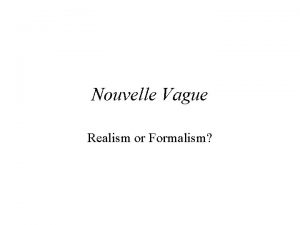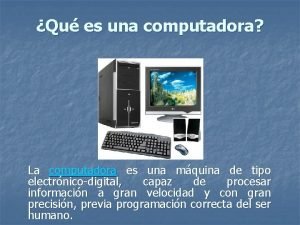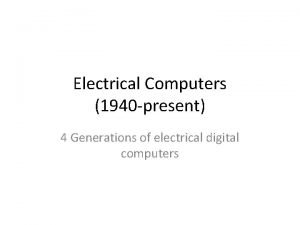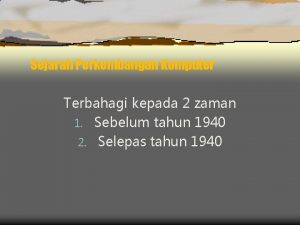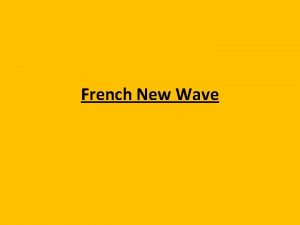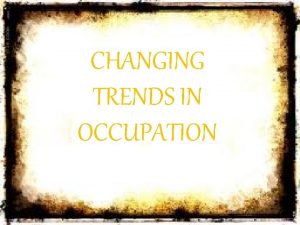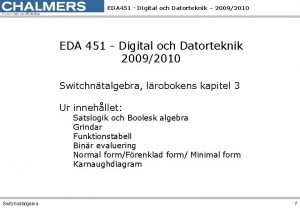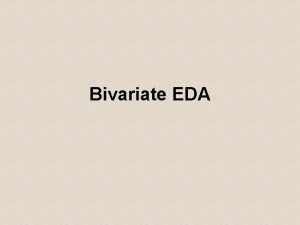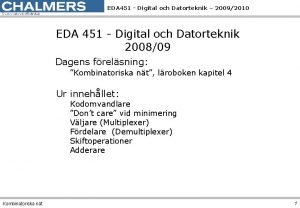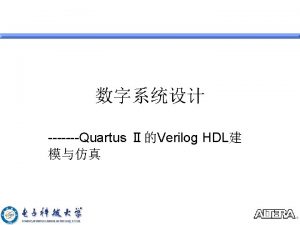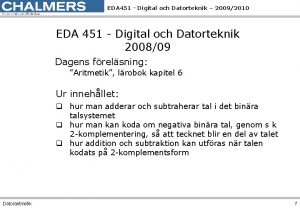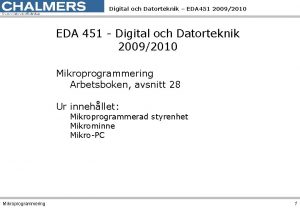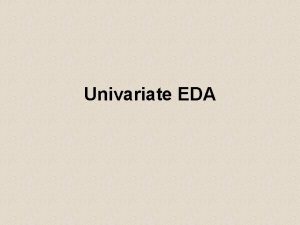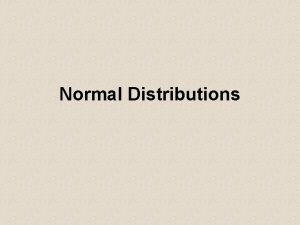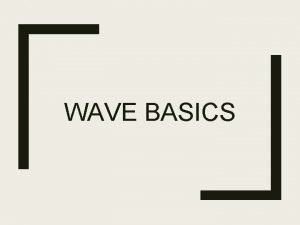FRENCH NEW WAVE Eda Aganoglu THE OCCUPATION 1940






















- Slides: 22

FRENCH NEW WAVE Eda Aganoglu

THE OCCUPATION (1940 -1944) • • Shortages, lights off, curfews !Main distraction is the cinema! AMERICAN FILMS German censors must approve first

AVANT-GARDE ANDRE BAZIN ERIC ROHMER

CINEMA!!

1944 • FRANCE WAS LIBERATED FROM THE GERMAN OCCUPATION • Blum-Brynes Agreement It’s time to catch up! • Liberation brought great desire of SELF-EXPRESSION, OPEN COMMUNICATION and UNDERSTANDING • L’Ecran Francais

BIRTH OF AUTEUR THEORY Another writer at the magazine who shared Bazin’s sense of aesthetics was Alexandre Astruc. In 1948 he wrote an article titled “Birth of a New Avant-Garde: The Camera as Pen”, in which he argued for cinema, like literature, to become a more personal form, in which the camera literally became a pen in the hands of a director. The article would become something of a manifesto for the New Wave generation and a first step in the development of “auteur theory”.

NEW WAVE • Late 1950 s to late 1960 s rise of a new generation of filmmakers • Directors born before WW 2, postwar in adulthood • Japan, Canada, England, Italy, Spain, Brazil, US (all had their new waves) • Most influential group appeared in France

CAHIERS DU CINEMA • Mid 1950 s, a group of young men who wrote for the Paris film journal (Cahiers du Cinema) made a habit of attacking the most artistically respected French filmmakers of the day. • =Rejected the traditional French filmmaking; loved commercial Hollywood • They claimed the auteurs existed in American cinema. Auteur= Usually did not literally write scripts but managed nonetheless to stamp his personality on studio products, transcending the constrains of Hollywood’s standardized system.

SOME AUTEURS Samuel Fuller Howard Hawks Otto Preminger Nicholas Ray

CAHIERS DU CINEMA Jean-Luc Godard François Truffaut Eric Rohme r Claude Chabrol Jacques Rivette

JEAN-LUC GODARD (referring the traditional French directors) “Your camera movements are ugly because your subjects are bad, your casts act badly because your dialogue is worthless; in a word, you don’t know how to create cinema because you no longer even know what it is. ”

CAHIERS DU CINEMA • Writing criticism didn’t satisfy these young men. They itched to make movies. • Borrowing money from friends and filming on location, each started to shoot short films. By 1959, they had become a force to be reckoned with. • In 1959… 1. Godard- A Bout de Souffle ( Breathless) 2. Rivette- (Paris Belongs to Us) 3. Chabrol-Les Cousins 4. Truffaut- (The 400 Blows) (won the Grand Prize at the Cannes Festival) The novelty and youthful vigor of these directors led journalist to nickname them la nouvelle vague- the New Wave.

CAHIERS DU CINEMA All told, the five central directors made 32 feature films between 1959 and 1966; Godard and Chabrol made 11 apiece.

SOME CHARACTERISTICS OF FRENCH NEW WAVE • LOW BUDGET!! • Casual look in movies instead of traditional French cinema-cinema of quality • Shooting in location instead of studios (mise-en-scene actual locales) • Available light instead of glossy studio lights • Simple supplemental sources • Flexible, portable camera equipment, leading to lots of panning and tracking shots • Lightweight camera that could be handheld (in Breathless, the cinematographer held the camera while seated in a wheelchair to fallow the protagonist)

SOME CHARACTERISTICS OF FRENCH NEW WAVE • Casual humor (Truffaut’s Shoot the Piano Player) • References to other films, Hollywood or European(Hitchcock is frequently cited) = Such gags, took some of the solemnity out of filmmaking and film viewing. • Casual connections become too lose. (Protagonist accidentally meets with a character on street and they talk, even though he has nothing to do with the film’s narrative) • Films often lack goal oriented protagonists. • Films often end ambiguously (End of Breathless)

END OF THE ERA • • • Despite the demands, the French film industry wasn’t hostile to the new wave. In 1957, cinema attendance fell of drastically, because television became more widespread. By 1959, the industry was in crisis, so the New Wave directors shot films much more quickly and cheaply. Although each New Wave director had his own production company, they got absorbed in film industry. (Ex: Godard made Contempt for a major commercial producer; Truffaut made Fahrenheit 451 for Universal; Chabrol began turning out parodies of James Bond thrillers) The exact date of the end of the era is difficult, many says it’s 1964, when the characteristic New Wave form and style had already become diffused and imitated. After 1968, the political upheavals in France altered the personal relations among the directors, the group dispersed.

EXAMPLES OF SOME MOVIES

EXAMPLES OF SOME MOVIES

BREATHLESS (JEAN-LUC GODARD) (1960) • Best example of the movement. • Although the plot is simple, the film itself is stylistically complex and revolutionary. • All the trademarks of the movement (jump cuts, hand-held camerawork, a disjointed narrative, an improvised musical score, dialogue spoken directly to the camera, frequent changes of mood and pace, the use of real locations) exist.

LEAD ROLES JEAN-PAUL BELMONDO JEAN SEBER G

BREATHLESS INFORMATIVE VIDEO https: //www. youtube. com/watch? v=3 Iz 3 JTGHRh 0

WORK CITED • Film Art, David Bordwell- Krostin Thompson • http: //www. theblackandblue. com/2010/03/29/the-french-new-wave -a-cinematic-revolution/ • http: //www. newwavefilm. com/about/history-of-french-newwave 3. shtml • http: //www. newwavefilm. com/new-wave-cinema-guide/nouvellevague-where-to-start. shtml
 Nouvelle vague definition
Nouvelle vague definition Belmondo osu
Belmondo osu Sound waves are transverse waves true or false
Sound waves are transverse waves true or false Long waves and short waves
Long waves and short waves Difference between full wave and half wave rectifier
Difference between full wave and half wave rectifier Longitudinal vs transverse waves
Longitudinal vs transverse waves Half wave full wave rectifier
Half wave full wave rectifier Half wave rectifier mathematical analysis
Half wave rectifier mathematical analysis Determining the arrival times between p-wave and s-wave
Determining the arrival times between p-wave and s-wave Rectified sine wave fourier series
Rectified sine wave fourier series Longitudinal wave
Longitudinal wave Wave wave repeating
Wave wave repeating When does a wave posses a quarter wave symmetry?
When does a wave posses a quarter wave symmetry? Mechanical and electromagnetic waves venn diagram
Mechanical and electromagnetic waves venn diagram Mechanical waves and electromagnetic waves
Mechanical waves and electromagnetic waves Transverse wave and longitudinal wave example
Transverse wave and longitudinal wave example Frida kahlo self portrait with monkey 1940
Frida kahlo self portrait with monkey 1940 Que es una computadora
Que es una computadora Qarardad e lahore 1940 in urdu
Qarardad e lahore 1940 in urdu Edvac full form
Edvac full form Ve day times square
Ve day times square Executive order no. 117 summary
Executive order no. 117 summary Sejarah perkembangan komputer
Sejarah perkembangan komputer
